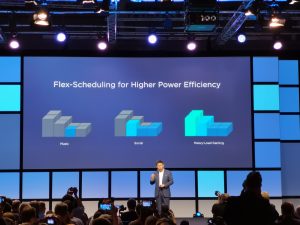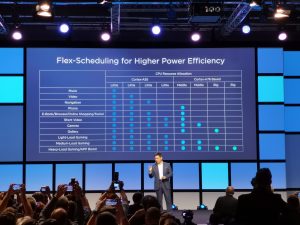
We’re live at IFA where Huawei has just announced the brand new top of the line mobile processor — the Kirin 980 System on a Chip (SoC). Huawei is the first to market with an ARM processor fabricated utilising a 7nm lithography process. What does this mean? More power for less battery, put simply. Let’s dive in to what the 980 will offer. Strap in, chip nerds: here comes a whole lot of sexy numbers.
Right out of the gate (chip pun) Huawei is firmly positioning the Kirin 980 as a AI-focused processor, claiming “The Ultimate Power of Mobile AI”. Introduced by Huawei Consumer Business Group CEO Richard Yu, the Kirin 980 is the first processor coming out of TSMC’s 7nm foundry. With 6.9 Billion transistors (that’s a lot) the 7nm process has given the Kirin 980 a 20% performance improvement over a similar 10nm chip, and a whopping 40% efficiency boost.
The Kirin 980 is an Octa-core processor and the first SoC to utilise the new ARM Cortex A76-cores which can bring individual improvements of up to 75% performance and 58% efficiency over older Cortex designs. The cores are configured in a 2 x high performance A76, 2 x high efficiency A76 and 4 x “extreme” efficiency A55 cores, Huawei is calling this big.Middle.LITTLE architecture. This is all managed by a new CPU subsystem to intelligently manage the scheduling of CPU cycles for maximum performance and efficiency.
The integrated graphics processor has been updated to the latest Mali-G76 GPU bringing along a 46% improvement in processing power with an unbelievable 178% improvements in power efficiency. The Kirin 980 also has same gaming specific features to set the processor into game mode when a game is detected; this might make this the ultimate PUBG device for Android.
AI
What AI focused chip would be complete with out specific AI components? The Kirin 980 includes dual Neural Processing Units (NPU). This dual NPU configuration has allowed Huawei to achieve a 120% improvement over the Kirin 970 in time to recognise an image, a good test for on-board AI. The chip has been specifically optimised to work with the popular AI frameworks including Caffee, Tensorflow and Tensorflow Lite. This, along with a suite of development tools, allows the Kirin 980 to provide unparalleled on-device AI processing.
Imaging
I think it’s fair to say the camera performance is one of the battlegrounds of the premium mobile device, and in recent years computational photography has begun to supplant lenses and sensors as a major component in overall image quality. To that end the Kirin 980 has increased the computational ability of the included Image Signal Processor ISP by 46%. This will allow devices powered by the Kirin 980 to access significant power-efficient image processing capabilities.
Video on mobile is also becoming increasing more important for both pros and home users. The ISP on the Kirin 980 will improve video capture time by 33% meaning you’ll have those videos finished and ready for sharing in no time.
Connectivity
The wireless modem in the Kirin 980 is the first to support the LTE Cat 21 standard, allowing up to 1.4Gbps throughput utilising carrier aggregation across multiple bands. Huawei is positioning this as a world modem, allowing the device to move seamlessly between carriers and countries as users move around. Huawei has designed the Kirin 980 to be 5G ready by building in compatibility with their Balong 5000 5G modem standalone chip, devices that include the Balong 500 modem will be 5G ready at launch.
However you look at it, the Kirin 980 is a feat of mobile engineering. Huawei is definitely showing its prowess as a vertically-integrated company and controlling their own SoC design is truly beginning to reap rewards. I can only image the kind of performance we will see in a device powered by the Kirin 980, now we just have to wait for one to come out, because with a chip this powerful I can’t imagine Huawei will wait long to let consumers take it for a spin.
Huawei announced that the first device to ship with the Kirin 980 will be the Huawei Mate 20, the Mate 20 will launch in London on the 16th of October.








Waded through all the numbers, and do you know what, they’re all boring and irrelevant, I’m afraid. Surely what matters is what it means for customers, and the big question there is “how long will my phone last on a full charge?” with this fancy new chip of yours.
Sounds impressive , roll on october ..